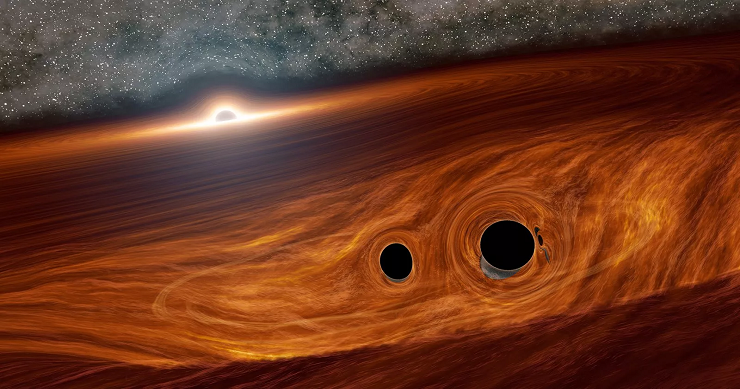Scientists have confirmed that the supermassive black hole M87*, which is located in the heart of the Messier 87 galaxy about 55 million light-years away from Earth, is spinning. This black hole became famous in 2019 when it was the first to be imaged, appearing as a fuzzy orange donut which was later sharpened by AI into a skinny ring. The speed at which M87* is spinning is still unknown.
For the past two decades, a network of radio telescopes has been observing this black hole. They have been particularly interested in a powerful jet of radiation and particles blasting from the black hole’s poles. New results show that this jet appears to swing like a pendulum on an 11-year cycle due to gravitational interactions between the spinning black hole and the disk of material around it. This provides “unequivocal evidence” for the black hole’s spin, according to scientists.
The jet changes its direction by roughly 10 degrees every 11 years. These results align with theoretical supercomputer simulations and will help scientists understand how black holes form and evolve. In 2019, astronomers observed wobbling jets escaping from a black hole much closer to us, about 8,000 light-years from Earth. These jets swung over periods of just a few minutes, which are the most rapid oscillations of this kind observed by astronomers to date.
The latest findings show that the jets from M87’s black hole follow a much longer timeframe, but are still consistent with theoretical predictions made by Einstein in his theory of general relativity. According to this theory, the spinning black hole is so massive that it pulls the surrounding fabric of space and time inward in what’s called frame-dragging. This effect was observed in the new study because the spin axis of a black hole is not perfectly aligned with the rotation axis of the surrounding accretion disk from which the black hole sucks stellar material. This triggers the black hole’s jets to wobble slightly.
The specific processes that cause black holes to spin are not very well understood. One leading theory suggests that smaller black holes form by feeding on star matter through an accretion disk, which causes them to spin rapidly. Over time, they are thought to collide and eventually merge to form supermassive black holes. These second-generation black holes are expected to spin slower compared to their younger counterparts. To confirm this hypothesis, researchers need to study spin rates of black holes of different sizes. The latest study could be a step in that direction.
Key Takeaways:
- The supermassive black hole M87*, located in the galaxy Messier 87, has been confirmed to be spinning, though the speed of its rotation is not yet known.
- Observations of a powerful jet of radiation and particles swinging like a pendulum on an 11-year cycle from the black hole’s poles provide strong evidence of the black hole’s spin.
- The study’s findings align with Einstein’s theory of general relativity, as the spinning black hole is so massive it pulls the surrounding fabric of space and time inward, an effect known as frame-dragging.
“The supermassive black hole M87*, which rose to fame in 2019 when it became the first void to be imaged and revealed a fuzzy orange donut (then later sharpened by AI into a skinny ring), is now confirmed to be spinning. The announcement of this update came on Wednesday (Sept. 27). However, as to how fast M87* is spinning? That’s not yet known.”
More details: here


Leave a Reply